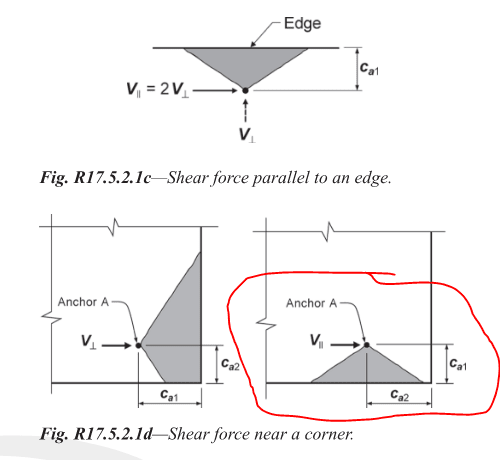Just for "fun", I ran an analysis of this layout in a tool I created for anchorage design. Assuming 3,000 psi, cracked concrete, 3/4" diameter F1554, Gr 36 ABs spaced on a 9"x9" grid, no supplemental reinforcement, and some other conservative assumptions, for your "Bracing Reaction" load acting in the positive x direction (to the right), I get an available concrete breakout strength in shear of about 14 kips.
The controlling case for breakout is actually the perpendicular (right side) of the pier failing. The breakout capacity of the parallel side (top side per plan view) is roughly double that. The capacity calculated in this software is based on the assumption that only the upper right AB is resisting the entire shear force, which may be quite conservative (although I have my reasons). If the anchor bolts are fully connected to the base plate (or if this happened to be an embedded plate with shear studs instead), then it would be more reasonable to use the row of ABs located farthest from the breakout surface to calculate the capacity.
In case you were hoping to use reinforcement to resist the breakout failure but aren't able to fully develop the rebar as required by ACI 318-14, Section 17.5.2.9, it's still possible to get some additional benefit of reinforcement. The psi_c_V factor (see Section 17.5.2.7) used in the breakout capacity calculation can provide an increase of up to 40 percent versus cracked concrete with no reinforcement. This 40 percent increase would be realized if there is reinforcement of a #4 bar or greater between the anchor and the edge and the reinforcement is enclosed within stirrups at 4" o.c. max. In addition, a greater phi factor (Section 17.3.3) is also allowed where supplementary reinforcement is provided.
This doesn't address your original question, but in case it's of value, based on the analysis that I ran, the controlling strength is actually limited by the steel strength of the AB and not on a shear breakout failure. Again, this is based on the assumption that a single AB is resisting the full shear force, which might not be a reasonable assumption in your case. As noted, the calculation is also based on a 3/4" diameter, grade 36 AB which might not be the case for you.

